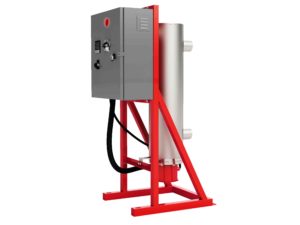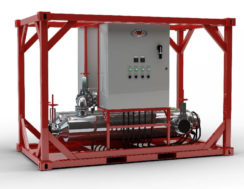Inline Heaters
In line water heaters (a.k.a circulation heaters) are ideal for processing fluid, including hazardous liquids, that requires intermediate heating while maintaining a flow rate. Instead of stripping the heat from another source as it would for a heat exchanger, an In line water heater simply transfers the heat generated from electrical power into the target fluid. The main characteristics of the in line heater are for efficient heat transfer, the easiness to install and to maintain, and its high range compatibility with the current standard industrial piping. Applications such as waste oil, steam and water processing can use in line heaters in order to regulate and control the temperature, but also to maintain the fluid viscosity. An improper liquid viscosity could gradually slow down the overall processing time of the production. In addition, the product’s final yield and purity could also be affected by a slight deviation of the viscosity. To avoid this type of problem, a heater inline is used to heat the fluid so that at the proper temperature, the viscosity remains unchanged and at the same time to process the medium at a desirable steady flow rate. To control the liquid flow rate of the heater, the wattage can be manipulated and regulated to obtain the desired temperature (in other words, the flow rate is directly proportional to the temperature/liquid viscosity). 
Shipping
Wattco uses its decades of experience shipping our industrial heaters worldwide. When shipping across borders, Wattco can handle all necessary import, customs and duties responsibilities to ensure that you receive your product on time and on spec. Wattco ships using all mediums upon request including: truck, train, container ship and by air freight when mission critical rush delivery is required.In line Heater Details
An in line water heater is composed of an immersion heater covered by an anti-corrosion metallic vessel chamber. This casing is mainly used for insulation to prevent heat loss in the circulation system. Heat loss is not only inefficient in terms of energy usage but it would also cause unnecessary operation expenses. A pump unit is used to transport the inlet fluid into the circulation system. The fluid is then circulated and reheated in a closed loop circuit around the immersion heater continuously until the desired temperature (up to 1000°F) is reached. The heating medium will then flow out of the outlet nozzle at a fixed flow rate determined by the temperature control mechanism.

- Industrial Flanged Heater Designed to meet most stringent requirements
- Sizes from 2 – 14” Stainless Steel, galvanized carbon steel pipe body, 150 LBS up to 1200 LBS Construction
- Up to 650 kW power requirement
- 120, 240 and 480V, 575 and 660V, 1 & 3 Phase available
- NEMA 1 General Purpose, NEMA 4 Moisture Resistant NEMA 7 Explosion Resistant Terminal Enclosures
- 0.430 inch dia and 0.475” Dia. tubing available using copper, steel, stainless sheath elements
- With & Without Thermostat, using thermocouples and digital temperature controllers
- UL, CSA, ASME and Other Third Party Approval, Listing or Certification Available on Many Models

